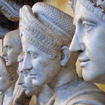TP2 // Art and Music // 03.06.2014
Pre-Intermediate level
Description
Materials
Main Aims
-
To provide gist and specific information reading practice using a text about the true stories of how important pieces of art were found in unexpected places.
Subsidiary Aims
-
To provide clarification of new vocabulary and practice speaking fluency.
Procedure (39-45 minutes)
T shows a picture of Picasso and asks if they know anything about him, shows some of his famous artworks. T asks Ss if they know any famous names. After this little discussion, the pieces of paper (where the pairs of art and artists are written on) are given to each student. Ss get either a piece of art or an artist. T do ICQs to make sure the instructions were given clear. Ss mingle and find their matching partner. At the end T hears the pairs while sticking the pictures of artist and the work of art on WB. Elicit some Turkish names that are related to art. Students remain with their new partner.
At this stage, Vocab&Speaking.Ex.1 will be executed. T will put HO#1 in the air and say "I would like you to work in pairs and match the words in the box to the pictures please". T asks ICQs and then give HO#1 and HO#2 to Ss. When they finish, T ask each pair to give an answer, meanwhile T can do some checks of meaning and pronunciation drilling. T will have some images ready in color about those new words and while talking about their meanings, the images can be shown on WB via projector.
T writes DISCOVERED on WB and says "Who discovered America" and if T is unsure that Ss don't know the meaning then says "I searched for all morning for my pens, finally discovered them in my bag" T aims to tests knowledge about this word. T writes the text heading on the board and tells Ss they are going to read 4 short stories about some very interesting "discoveries" of important pieces of art. T will elicit the meaning of "valuable" and "unexpected" from the students. "Do you think gold is valuable? Does it worth loads of money?" T tells a personal story to elicit the meaning of unexpected:My friend called me and she was crying on the phone. She said her father died. Her father was a healthy man, he wasn't sick and didn't have any accident. His death was unexpected" T asks Ss to read the text very quickly and also reminds them not to read every single word. Ss should match each story to one picture (Ss individually) Once they have finished, they can check their answers with their partner. T asks ICQs to make sure they understand the instructions. While SS are reading, T writes the heading of stories on WB and once Ss have finished matching, they can go and write the letters of the pictures next to the headings (WCF)
T refers Ss to the glossary and check these words before Ss read the text again. T asks questions regarding the words like "what does an archaeologist do?", "what can you buy at a flea market", "do you think a peasant have any money?" T asks Ss to read the text again(individually) and complete the sentences (Reading Ex.2) according to the text (S). T informs Ss that when they finish they can check it with their partner.T checks Ss understanding with ICQs. While they are doing the activity, T sticks the pieces of papers where the answers written on the walls around the class. Once Ss have finished with completing the sentences, T askes them to look around with their pairs for the correct answers.
T asks Ss to think about an object that is important to them or to their families. Ss will need to use the questions that are provided by the book (Speaking/Activity A) and find at least 2 people and talked to them. While getting the information, Ss will use a piece of paper that is provided by T to make some notes. After giving the instructions, T will have to do ICQs. While Ss are talking, T needs to monitor and writes errors on WB to clarify them after the activity. T also asks a few of Ss to share their findings about the people that they spoke to.

